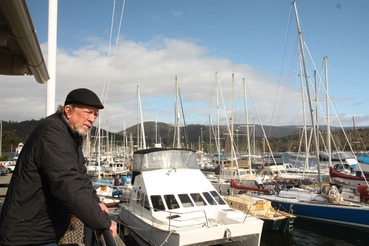
While they call it Bruny Island, you’re actually looking at two separate islands joined by a narrow five kilometre sandy isthmus called The Neck where a timber boardwalk takes you to the Truganini Lookout with 360° views of the coastline, the Passage and the mainland on the other side. The isthmus is an important breeding site for Short-tailed Shearwaters and Fairy Penguins, and while the Eco Cruise bus doesn’t stop there, it’s pencilled in if we’re ever back that way with our own transport.
Your own transport is a significant consideration with a geographic feature that’s the best part of a hundred kilometres long with 225 kilometres of roadway. The main sections between the ferry terminal at Roberts Point and Eco Cruise headquarters at Adventure Bay are sealed, but the road across The Neck isn’t, due largely to the shifting nature of the sandy isthmus, and wasn’t constructed until shortly before the ferry service started operating in 1954. Before the road, you travelled between North to South Bruny along the beach at low tide. On that basis, you’d guess the dunes are significantly higher now, but maybe the beach was used because it was an easier option than scrub bashing over sand dunes.
Historically, human habitation goes back around 50,000 years to the Ice Age when Tasmania was joined to the Australian mainland. Sea levels were around 80 metres lower than they are today, and much of central Tasmania would have been covered in glaciers, and milder temperatures near the coast would have been preferable to the chilly interior.
The tribal group that lived in the region were the Nuenonne, whose traditional territory stretched from Hobart’s Sandy Bay to Port Davey around on the south west coast of the island. Their name for Bruny Island (Lunawanna-Alonnah) lives on in the names of two towns on the west coast of South Bruny.
Abel Tasman reached Bruny in 1642 with his ships Heemskerck and the Zeehaen, briefly entered Adventure Bay and attempted to land but inclement weather meant it was another hundred and thirty years before Europeans set foot on the island.
That was Tobias Furneaux, the first recorded European to land at Adventure Bay, which takes its name from his ship, but the Frenchman Marc-Joseph Marion du Fresne (sometimes spelled Dufresne) had sailed past a year earlier with the Mascarin and the Marquis de Castrieson. The Frenchman was the first European to set foot on Tasmanian soil, but that was at Marion Bay on the north side of the Tasman Peninsula rather than on Bruny Island. From Van Diemen's Land, he sailed on to meet a grisly end in New Zealand.
Furneaux’s HMS Adventure was one of the two ships in James Cook's second expedition in search of Terra Australis. Cook’s first voyage had gone part of the way to debunking the notion of a vast undiscovered continent by circumnavigating New Zealand (previously sighted by Tasman), proving it was not attached to a larger landmass. There was a substantial body of opinion led by Alexander Dalrymple and others of the Royal Society that suggested Terra Australis lay further south.